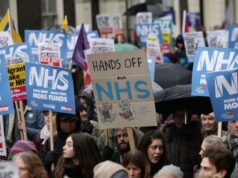Issue: 72
2 November 2018
NHS North West London’s ‘Transformation’ Strategy Crashes and Burns as it Finally Admits to Cancelling the Closure of 500 Beds
On 1 November 2018 NHS bosses in North West London (NWL) finally conceded defeat in their 2012 ‘Shaping a Healthier Future’ (SaHF) strategy. Reducing the number of ‘Major Hospitals’ from nine to five was the major plank of SaHF. In six years they managed to get it down to seven, but now concede (ostensibly till 2023) that the Acute hospitals at Ealing and Charing Cross will not have their Acute beds removed. In fact the number of beds at both sites are being increased.
Surely this is the last straw for SaHF. A list of previous SaHF failures can be found in my missing business case piece below.
NHS NWL is Still Confident it Will Soon Win Approval For its Re-Request for £513 Million for Building Work
Also on 1 November 2018, NHS NWL boss Mark Easton publicly stated that he expected the resubmitted SaHF ImBC SOC1 business case for £513 million for capital projects to be approved ‘soon’. With just months to go until the UK leaves the EU, with tens of £billions at risk, the idea that H.M. Treasury would agree to give NHS NWL £0.5 billion for building work is beyond ludicrous.
Ealing Out Of Hospital Services Contract Not Awarded to a Single Supplier
Our local NHS mental healthcare service supplier is the first company named in a list of five companies announced on 30 October 2018 by Ealing CCG as the winner of the 10 year, £450 million contract. This lead winner received poor CQC reviews in both 2016 and 2017.
The five organisations named in the press release are:
+ West London NHS Trust (was until very recently called West London Mental Health NHS Trust)
+ Central & North West London NHS Foundation Trust (the only other NHS mental healthcare service supplier in North West London)
+ Hillingdon Hospitals NHS Foundation Trust (which runs Hillingdon Hospital – regularly one of the worst performing Acute hospitals in England since 2015)
+ Marie Curie (‘Care and Support through terminal illness’ charity)
+ Mind (mental health charity)
Also mentioned are ‘other local organisations’ (the number of which and their names are not identified).
There is no single supplier here. Surely this makes the whole procurement process flawed. There has been no overt attempt to create a consortium of the seven (maybe 10, 15…) organisations. What is even more bizarre is that the current supplier of 25 of the 36 OOH Services covered by the contract is our local Trust here in Ealing – the London North West University Healthcare NHS Trust (LNWUH). LNWUH, by the way, was one of two London Trusts which refused to bid for the contract on the grounds that the money on offer was insufficient to provide quality services.
I’m certainly glad that Virgin Care didn’t win the contract. But rumour has that they did submit a bid. If they did, they may well claim compensation – a stroke they have pulled before. I wonder whether we will ever discover, officially, which organisations – single supplier or a group of organisations – actually submitted bids. However, the ever secretive ECCG is unlikely to tell us.
Finally with our local mental health NHS Trust (‘West London’) taking the lead on this contract how might these new responsibilities affect its faltering core mental health services? In 2017, CQC rated nine of its eleven core mental health services as ‘Requires Improvement’. In another bizarre twist on secondary mental health services, it appears that all eight NHS NWL CCGs have delegated ‘upwards’ the commissioning role for this to the non-Statutory NHS NWL Collaboration of CCGs. How this will work is unclear as this collaboration appears on the face of it to be just a set of meetings. However as is the way seemingly in the NHS maybe the Collaboration now employs staff.
Maybe Jam Tomorrow for Mental Health Services According To Hammond’s Budget
On 29 October 2018, Chancellor Hammond announced an additional £2 billion for NHS mental health services in England. Was this new money? No it wasn’t – it’s part of the £20 billion for the NHS announced by Prime Minister May in July 2018. Allegedly ‘the increase’ will begin in 2019/20 but will not be ‘completed’ till 2023
The announcement says little specifically about increasing the number of mental health beds, recruitment and training of more psychologists and other mental health staff. The idea of mental health teams in schools seems helpful on the face of it. But who will staff these teams? Do schools have room for a mental health team? Will teachers be trained as mental help workers? Promising to add specialist mental health support to A&E departments shocks me as I naively thought such support was already universally in place across England.
There’s also no commitment to ring fence this money for mental health use. Both NHS Trusts in North West London which supply mental health services are no longer dedicated just to mental health. In future Integrated Care Providers will ultimately decide how or if this money is spent on mental healthcare and mental social care.
However the caveat to all this is that if Brexit goes pear shaped the NHS budget increase will just not take place at all.
Why Are Business Cases for NHS Transformations Being Withheld From the Public?
I’ve been tracking NHS ‘Transformations’ now for over six years. The NHS intentions for transformations are better outcomes for patients and cost reductions. In a conventional business you would probably borrow money from the bank in order to transform your business. You would write a business plan/business case which would which would have projections of costs and profits. For a private business this business case would only be shown to investors and the bank. For public businesses the investors would be the general public and the business case should be shown to them.
What happens in the NHS?
+ NHS North West London (NWL) ‘Shaping a Healthier Future’ (SaHF)
A ‘final’ business case for this project launched in 2012 appeared in the public domain in December 2016. In September 2017, NHS England (London) and NHS Improvement (London) both rejected the business case. This business case was entitled ImBC SOC1 and it requested £513 million for building work. The cash was intended for GP Surgeries and Acute facilities expansion and the creation of healthcare ‘hubs’. Deploying capital in this way would apparently justify the closure of Ealing and Charing Cross as Acute hospitals.
We have been led to believe that a revised version of SOC1 has been drawn up by NHS NWL bosses and submitted for approval to NHSE/I. NHS NWL has refused to place this new business case into the public domain. However it now appears that the original SOC1 has been resubmitted on a new, different set of forms. Wow! Maybe the new forms will make all the difference….
One of the ‘fragile’ elements of the original SOC1 was ambitious targets for reducing annual Non-Elective Admissions to Acute hospitals by 99,000 by 2015/26. These so called NELs are largely emergency admissions. A recent Freedom of Information (FOI) request to NHS NWL has revealed that NELs continue to rise (not fall) across NWL:
2013/14: 167,222
2014/15: 170,271
2015/16: 175,502
2016/17: 172,142
2017/18: 181,632
In fact the latest data for April, May and June 2018 show that for each month NELs were higher than each of the same months for the previous five years. So the trajectory is upwards not downwards.
On the cost saving front, the original 2012 SaHF public consultation document projected annual cost reductions of 4%. In the first year alone this would have amounted to £144 million in savings. However NHS NWL SaHF has yet to announce any cost savings at all.
In a quite distasteful fashion current SaHF /NHS NWLbosses have just published their own review of SaHF 2012 to 2018. There are few performance metrics in the 11 pages and there are some shocking errors and omissions, which include:
+ The SaHF benefits statement in the review is completely at odds with the 2012 SaHF benefits statement. In 2012 the benefits are localising , centralising and integrated. In the 2018 SaHF review they are personalised, localised, coordinated and specialised. More to the point the 2012 SaHF mission statement says ‘….changes that will improve care both in hospitals and the community and will save many lives each year’
+ Getting a GP appointment takes much longer in 2018 than it ever did in 2012
+ There are no estimates of lives saved by SaHF
+ The 2012 SaHF is purely about NHS physical healthcare transformation and as such is at odds with the 2016 STP and the 2018 Integrated Care Provider contract as the latter two also involve Local Authority social care services transformation and its integration with physical and mental healthcare services
+ The 2012 SaHF changes were to take ‘at least three years to put in place’. Six years on, the SaHF changes are still not in place
+ It was planned in 2012 to close four hospital A&Es, but only two have been closed.
+ After the two A&Es were closed in September 2014, A&E performance deteriorated massively across the whole of NWL, often being the worst in England. Whilst A&E demand has remained steady it’s only recently that there has been a modest recovery in performance
+ No reference to cost savings
+ So far SaHF has cost over £100 million
+ The 2016 SaHF ImBC SOC 1 business case requesting £513 for building work is still not approved
+ The SaHF ImBC SOC 2 business case requesting £314 million for building work has never appeared in public and little has been heard of it in recent years.
(+ Bed reduction strategy was dumped on 1 November 2018, and this really closes the book on SaHF).
When I ran my own business I performed performance reviews on my staff and on their projects. At school I was never allowed to mark my own homework – this was done by my teacher. It’s high time we had an independent review of SaHF. The last people who should be considered to review SaHF are past and present SaHF bosses.
You can view this partial view of SaHF history at:
www.healthiernorthwestlondon.nhs.uk/sites/nhslondon/files/documents/8._nhs_in_nw_london_-_overview_of_strategic_developments_since_2012.pdf
+ Ealing Out Of Hospital (OOH) Services Contract
Ealing CCG refuses to release the business case supporting this single supplier, 10 year, £450 million minimum contract. ECCG’s reason for withholding this document is that it is commercially sensitive. Well this might have been the case prior to bids being submitted. All bids were submitted by 23 August 2018, so why not release the business case now? What has ECCG got to hide?
ECCG has stated publicly that the single supplier OOH Services contract will not reduce costs. It said cost reductions would be achieved by reductions in NELs. FOI data tells us the ECCG NELs in 2013/14 were 31,335 but by 2017/18 they had risen to 32,561. So the trajectory is upwards not downwards.
As of 30 October 2018 we now know that at least seven organisations have been awarded this ‘single supplier’ contract. Bonkers or what?
+ Integrated Care Provider (ICP) Contract
ICP contracts could, when signed and implemented nationally across the coming decade, amount to £100s billions in value. But, where is the ICP business case? Where in fact is the Integrated Care business case? I can’t find them.
All that seems to exist are various papers written by McKinsey & Co from 2009 onwards containing the dogma that 40% of patients occupying Acute hospital beds shouldn’t be there. Along with this are somewhat dated performance metrics from some of the 50 NHS Vanguards, showing some reduction in the growth rate of NELs. Launched in 2015, these are grant funded experiments, whose results may not emerge till 2020/21. £389 million has already been spent on them but the National Audit Office (NAO) said in June 2018 that it could find no evidence of cost savings. In a stunning NAO statement it noted that ‘NHS England does not intend to continue measuring savings’.




